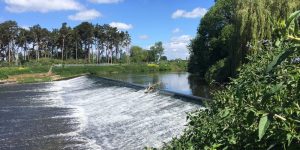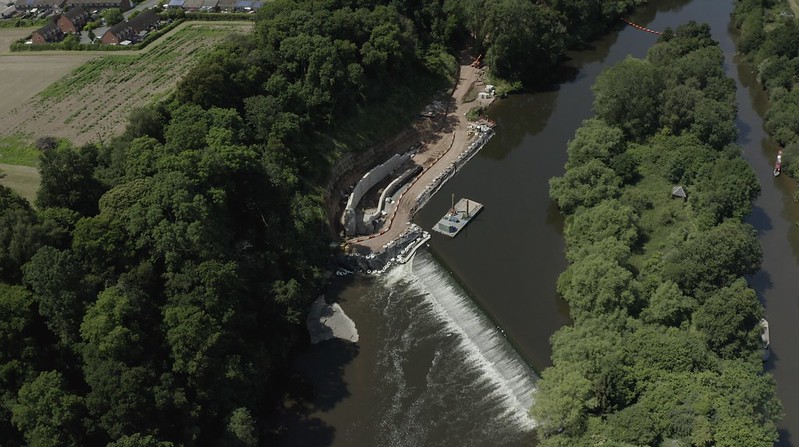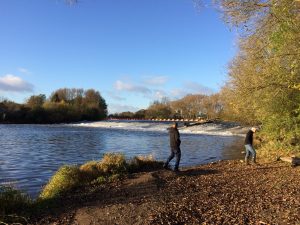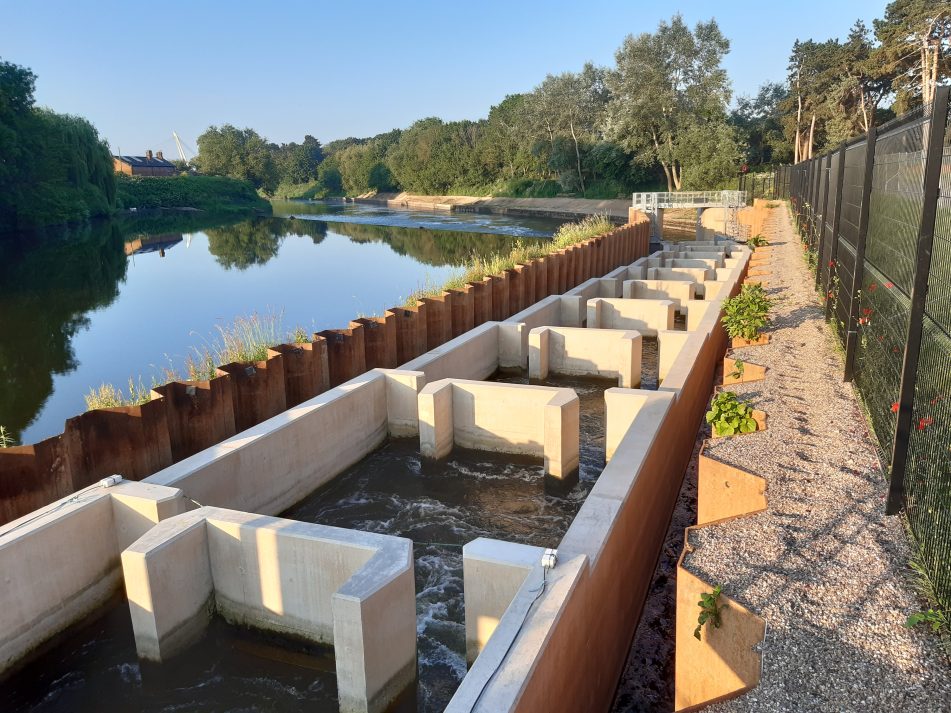
Fish passes give fish a route around an artificial barrier in the river such as dams or weirs. They work by allowing fish to move up to a higher water level above a barrier, via smaller, more manageable steps. To work effectively, the fish pass needs to direct the flow of water through the structure so that it is not too fast or too turbulent for fish to comfortably swim through. In our first blog post on understanding fish passes, we discussed why fish need to be able to move past barriers. The second post discussed the scale of the problem of barriers on rivers and why fish passes or barrier removal are needed. In this third blog post on understanding fish passes, we explain the technicalities of how fish passes work and highlight some key factors that are essential for their success.
Fish passes help fish overcome a difference in water level around a barrier.
On the River Severn, a series of Victorian navigation weirs are barriers to fish between Gloucester and Stourport. Weirs are smaller than dams, and a less complete barrier, as they are designed to be overtopped by flowing water. But on a large river, weirs can still be substantial structures and a huge problem for fish. The weir across the River Severn at Diglis, Worcester is 2.5m high from crest to toe, with a steep ramp projecting on the downstream side. It is the first of the River Severn weirs that represents a complete barrier to twaite shad.
When we’re designing a way around a barrier for fish, it is not the actual height of the weir itself that determines the size and form of the fish pass. Instead, it is the difference in height of the river level up and downstream of the weir that drives the design calculations.
Fish passes work by breaking one big height difference at a weir or dam into a series of more manageable steps for the fish to swim through. If I asked you to jump up from the ground floor of your house to the first floor, unless you’re an Olympic pole-vaulter with a pole handy, you simply wouldn’t be able to do it. But most people can walk up the stairs, no problem. We can think of a fish pass in the same way; a fish pass provides a series of smaller manageable steps to get fish up to a higher water level past a barrier.
Note about weirs and water levels.
Weirs artificially raise the upstream water level. When a weir is built across a river, the water flowing down river builds up behind the weir wall until the top of the river water has risen up enough to cascade down over the weir crest.
The difference in height between the water level up and downstream of the structure is called the head drop. Head drop at the weirs on the River Severn can vary widely depending on how much flow is coming down the river. In full flood, the river will overtop the weirs and no weir is visible at all. Whereas in low flows you can easily see the full height of the weir exposed with a big difference between the upstream and downstream river levels being apparent. But the river level below varies according to how much flow is coming down the river. A fish pass needs to accommodate these fluctuations in head drop.
Unlocking the Severn is focused on returning the endangered twaite shad to their spawning grounds. Twaite shad migrate in the late spring when lower flow conditions are typical. At Diglis in Worcester, our fish pass has been designed to work for a maximum 2.5 metre head drop of water. So, even when the difference in the river level above and below the weir is at its highest, the fish pass will still allow fish to comfortably negotiate this 2.5 metre difference in water levels.
The 3 key elements of successful fish pass design
So far, so simple. But if the principle of the fish pass seems straightforward, getting the design right in practice is much more complex. At every stage: from encouraging fish to swim up to the fish pass, providing conditions that do not put fish off entering the pass, to managing the flow so that fish are physically able to swim the whole length of the structure; fish pass designers must think like a fish and consider some very complex hydrodynamics of the flowing water! And for a fish pass to work successfully, it must meet the needs of fish in these three distinct phases: approach, entry, and passage.
1. Approach
1a – Location of the fish pass
For a fish pass to work, first of all fish need to be able to find it! This may sound obvious but unfortunately it can be the reason that an otherwise fit for purpose pass could fail completely. It may be easy for us humans to spot fish passes. In our bright airy world above the river, we can use our eyes to sight them from far away. But you can’t see so far ahead when you’re a fish swimming within the river. Instead of relying on sight, fish sense their way to routes upstream by following the river flows. And fish can easily miss the entrance to a fish pass that is too far away from the barrier. For example, imagine a huge dam across a river, with a bypass channel starting 1km downstream of the dam. Fish are most likely to swim straight past the entrance to the bypass channel, if there is a much bigger flow of water issuing from the dam. The fish would be oblivious to an alternative route installed for them so far back downstream and unfortunately, they would be unlikely to ever find it.
On a much more local scale, the exact position of where we place the pass within or alongside the barrier is also really important. In the River Severn we are lucky that all the weirs are built in an angle across the river. If fish are trying to head upstream, then no matter what point they approach the weir, they will tend to keep trying to go upstream. So, fish are likely to track up along the weir in an upstream direction, and that channels the fish towards the upmost corner. Thus, we built the inlets of our Unlocking the Severn fish passes at the upmost corner of the weir, where the fish have the very best chance of finding them.
1b – Fish passes that work have significant attraction flows
Another common reason that fish might not find and approach a fish pass would be because there isn’t enough water moving through the structure to attract them towards it. We learnt in blog 1 how migrating fish follow currents and flow lines to head upriver. If the outflow of the fish pass is not significant enough to attract them, fish may simply never ‘find’ the fish pass or realise that it represents a potential route for them to get upstream. In the UK it is considered best practice for a fish pass to channel to contain 5 to 10% of the flowing water in normal river conditions. At times of higher river flow, common in winter months, more water pours over the weir crest. Whereas at lower flow conditions when we see a big expanse of the weir exposed, much less water is overtopping the weir. These low flow conditions would be typical in late spring when the shad migrate. We have designed our fish passes to be channelling 10% of the total flow across the river at that time.
The need for a fish pass to carry lots of water so that a strong outflow attracts fish, provides a conflict for the fish pass designer. Because channelling too much water through a pass of a fixed size can make the flow conditions fast and turbulent, creating conditions that are difficult or off-putting to fish. In the three deep vertical slot fish passes we have installed on the River Severn, special ‘augmentation channels’ along each side of the pass allow us to move a higher volume of water through the structure without affecting the flow conditions inside the pools where the fish swim through. [Read on to find out more about how the structures within the fish pass work.]
2. Fish must be willing to enter the fish pass
The conditions that fish find at the entry to the fish pass must not put them off attempting to enter the pass. The speed of the flow and the churn of the water are both important factors for how a fish pass works. Shad seem not to like turbulent water which has white water and strong eddies or counter currents. This might be because they are a shoaling fish, and churning water disturbs their ability to see and stay in contact communicate with the other shad.
We’ve had to take extra care in designing how to reintroduce the extra water carried through our augmentation channels in the final junction pool. This additional flow is important to attract the fish, but needs to avoid creating a turbulence mixing that might put off shad entering the pass. So, we’ve included design elements that help dissipate the energy of the additional water before it re-joins the rest of the flow at the base of the pass.
3. Passage through the fish pass
The final element to a making a fish pass work effectively is ensuring that fish can navigate the full length of the pass, and successful emerge upstream of the barrier. The more water a river carries, and the bigger the head drop at a barrier, the bigger the fish pass will have to be. Our fish passes at Diglis and Lincomb are deep vertical slot fish passes formed as a series of 11 ascending pools. This means we give fish 11 smaller, more manageable steps, to break up the one big difference in water height above and below the weir. The fish swim through vertical gaps between the pools. In the Diglis deep vertical slot fish pass, going up the pass, the base of each pool raises 20cm higher than the one before.
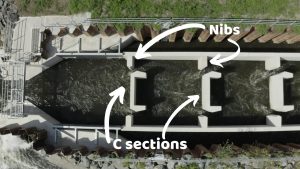 Controlling the speed and flow conditions within the fish pass are essential to make the fish pass work properly for fish. The structures that separate the pools in our deep vertical slot fish passes are the C-sections and the nibs. The flowing water is channelled at an angle through the gaps and directed towards the facing wall of the C sections which absorb some of the energy of the water and help slow it down. There are also areas of calmer water within each section of the where fish can rest if they need to. For example, beside the wall at the nibs is a particularly calm spot. Fish can then use a burst of faster swimming as they move through the faster flowing water from one pool to the next.
Controlling the speed and flow conditions within the fish pass are essential to make the fish pass work properly for fish. The structures that separate the pools in our deep vertical slot fish passes are the C-sections and the nibs. The flowing water is channelled at an angle through the gaps and directed towards the facing wall of the C sections which absorb some of the energy of the water and help slow it down. There are also areas of calmer water within each section of the where fish can rest if they need to. For example, beside the wall at the nibs is a particularly calm spot. Fish can then use a burst of faster swimming as they move through the faster flowing water from one pool to the next.
Deep vertical slot fish passes are only one kind of fish pass. They work well in the wide range of flow conditions that we experience on the River Severn. Deep vertical slot fish passes are also suitable for many fish species – all of which have slightly different needs and preferences for flow conditions. A layer of stones across the base of the fish pass is also important adding roughness that smaller fish can use as water right at the bottom slows down as it flows over the rough base. This is also particularly useful for smaller eels and lampreys.
Where there is plenty of space at the riverside, a long, gradually sloping bypass channel which contains boulders to break up the flow, makes an even more natural swim-way for fish. Only one of our fish pass locations had enough land available to make this possible. You will be able to read more about how a natural style bypass channel works in a future detailed content about our Bevere Fish Pass coming soon in the new year.
How does a fish pass work – summary
Fish passes are work by breaking one big jump in water height into a series of more manageable steps for the fish. How a fish pass works is simple in theory, but in practice, the design can be very complex! Fish passes need to provide a big enough outflow of water to attract fish. But they must carefully guide the flow of water within the pass and at the entrance, to reduce the speed and turbulence of the water. The Unlocking the Severn project includes comprehensive monitoring of the twaite shad. We can use both the acoustic tagging of shad and our 24-hour video monitoring in the Diglis fish pass to track how shad use the pass. We hope you will come and visit our flagship fish pass at Diglis, Worcester to see for yourself and learn more. If you book a guided visit in the spring or summer time you can even have a chance to see wild fish moving through the fish pass through its unique underwater viewing window!
In the meantime, do watch this animation based on the actual CAD (computer aided design) files which gives a better eye of a fish pass from the perspective of the fish!
And if you haven’t seen them already, you can also watch videos about our Diglis and Lincomb deep vertical slot fish passes:
Useful Links:
FishTek were the specialist consultants who designed our fish passes – read more here.
For a summary of other different types of fish passes see: https://theconstructor.org/water-resources/types-fish-ladders-fishways/33911/
More detailed, technical information on pool fishways, pre-barriages and natural by-pass channels is available to read here:
https://www.kmae-journal.org/articles/kmae/pdf/2002/04/kmae2002364s54.pdf

